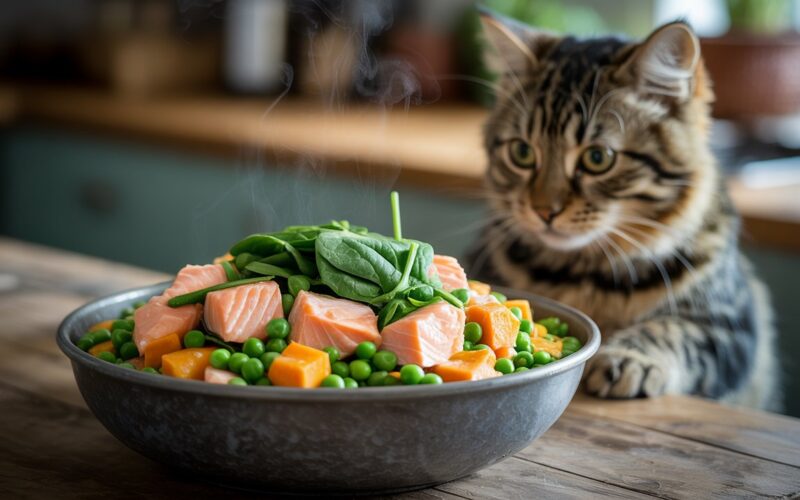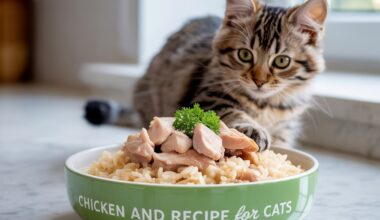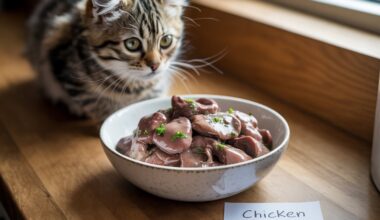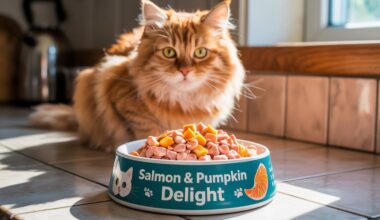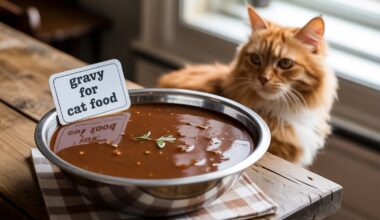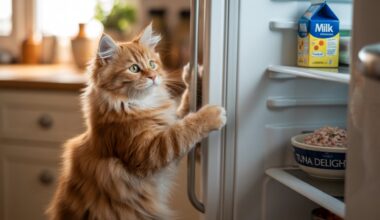Your favorite cat’s food is suddenly over, and now there is no chance of going to the market? I have discussed what you do in such a situation, how you can prepare safe and nutritious foods for cats in an emergency with the ingredients in the house.
Many people are hesitant about Cat Food Substitute or cat food options. What is safe to feed and what is not? Now we will know alternatives to Canned Cat Food, Cheap Alternative to Cat Food, and effective solutions related to Emergency Cat Food. In it you will find Cat Food Replacement Ideas that can be easily created that is not harmful to your pet’s cat’s health.
But remember, these are only temporary solutions. It is not safe to use any alternative foods in the long run without the advice of your veterinarian. Let’s see what your kitchen can be in your kitchen as an urgent meal for your cat.
1. Can I Feed My Cat Something Else?
Yes, you can feed your cat some alternative foods but do so with great care. Cats are “obligate carnivores” meaning they require certain types of animal protein for proper nutrition.
Foods that can be given to cats temporarily:
- Boiled chicken or turkey (boneless, without seasoning)
- Boiled eggs or scrambled eggs (without salt and oil)
- Tuna or salmon (better if preserved in water, can be given occasionally)
- Boiled rice and meat mixture (small amounts)
- Pumpkin puree (helps with digestion, only plain pumpkin)
Foods to never give to your cat:
- Onions, garlic, chives: toxic to cats
- Milk or dairy products: most cats are lactose intolerant
- Chocolate, caffeine, alcohol: very dangerous
- Dog food : lacks essential nutrients (such as taurine)
- Raw fish or raw meat : carries a risk of bacterial and parasitic infections
Veterinary advice:
Use these alternative foods only in emergencies and for short periods of time. Cats need taurine, vitamin A, and other important nutrients for their health, which can only be found in complete cat food.
2. What Can Cats Eat from the Fridge?
Some foods in your refrigerator may be safe for cats, but not all foods. Below is a list of some safe and dangerous foods that can be fed to cats from the refrigerator:
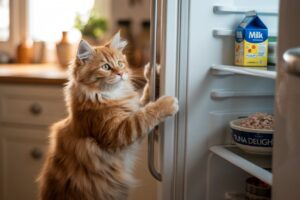
Foods that cats can eat from the fridge (if cooked and plain):
- Cooked chicken or beef (without bones and spices)
- Cooked fish (such as tuna or salmon) but without salt and oil
- Boiled eggs:if stored in the fridge, warm slightly before feeding
- Cooked rice or sweet potatoes: in small amounts, for fiber
- Pumpkin puree: if plain and without sugar/spices
Foods that cats cannot eat in the refrigerator:
Spicy cooked foods: such as biryani, bhuna, gravy. Milk or dairy products: most cats cannot tolerate lactose. Onion, garlic foods: toxic to cats. Bamboo, tomato, citrus foods: can cause digestive problems. Raw fish or raw meat: risk of bacteria or parasites.
Pro Tip:
- Try to bring food from the fridge to room temperature before feeding it.
- Make sure the food does not contain salt, oil, spices or bones — this is very important for cats.
- Unless it is an emergency, it is safest to feed food specifically made for cats.
3. Cheap Alternatives to Store or Bought Cat Food
If you’re concerned that you can’t provide good food for your cat, you’re in the right spot. You can provide your cat with excellent food even on a tight budget.
“Providing your cat with a healthy diet doesn’t need to be expensive,” stated Emma Passman, a pet nutritionist from the UK. “Choosing affordable cat food made with quality ingredients allows you to ensure balanced nutrition while maintaining low expenses.”
Passman recommends seeking foods that list actual animal protein as the primary ingredient, along with few fillers, in addition to vital vitamins and minerals for overall well-being. “Focusing on ingredient quality guarantees your cat receives the necessary nutrients for a healthy lifestyle,” she stated.
Having spent years researching the cat food market to determine which brands provide good value and which budget options are surprisingly effective, we’ve highlighted several cost-effective foods that surpass their more expensive rivals.
List of cheap Alternative Cat food
4. Homemade Cat Food Substitute Recipes
Cooking for your cat at home is a wonderful way to show affection. Fresh meat, ingredients without preservatives—everything might seem appealing. However, the issue is that often these foods fail to supply all the nutrients your cat requires. This is where “homemade cat food premix” becomes crucial.
Five Sample Recipes for Homemade Cat Food:
- Turkey Breast and Sweet Potato Recipe
- Raw Ground Rabbit Recipe
- Cooked Meat Recipe
- Prey Model Raw Diet Recipe
- Ground Chicken Thigh with Bone and Organs Recipe
Best cat food recipes with fish
I made Salmon & Pumpkin Delight for my cat, a fish-based cat food recipe that is homemade or serves as supplemental food. Salmon and pumpkin are typically safe and helpful ingredients for cats. Nonetheless, several crucial aspects must be considered when making a homemade meal for your cat.
5. out of cat food what can i use
If your cat runs out of food, don’t worry. You can temporarily use some safe food that you have at home. But remember that these foods are only suitable for emergencies and for short periods of time.
What you can give your cat if you don’t have cat food.
Protein foods: a. Boiled chicken or beef (without bones and spices), boiled eggs (scrambled or boiled, without oil and salt), canned tuna or salmon (preserved in water, can be given occasionally)
Carbohydrates and fiber: Boiled rice or oatmeal (in small amounts, helps digestion), Plain pumpkin puree (helps digestion).
6. When to See a Vet or Avoid DIY Cat Food
Consult a veterinarian if you see any of the following symptoms:
Excessive vomiting or diarrhea, sudden decrease or loss of appetite, lethargy, weakness, dull eyes, hair loss or skin problems, weight loss or bone spurs. These symptoms may be signs of nutritional deficiencies or food allergies/intolerances. Homemade food often lacks essential vitamins and amino acids.
Why is commercial cat food balanced and safe?
Commercial (branded) cat food: Scientifically balanced nutrition, taurine, vitamins A, D, B12, calcium, iron, etc. in the right proportions. Made according to different ages and health conditions
Each ingredient is verified according to human food standards. Therefore, instead of giving homemade food every day, packaged good quality food is the safest.
How to transition back to regular cat food:
- Make the transition gradually – sudden changes can cause digestive upset.
- First 3–5 days: 25% commercial food + 75% old (DIY or emergency) food
- Next 3–5 days: 50-50 mix
- Towards the end: 75% commercial + 25% old
- Make the transition completely. If the cat is eating well and not having digestive upset.
7. FAQs: Cat Food Substitutes
What can I feed my cat when I run out of cat food?
If your cat suddenly runs out of food, don’t worry. You can temporarily offer some safe foods. For example: boiled chicken or beef (without bones and spices), boiled eggs, tuna (preserved in water, without salt), or boiled rice and pumpkin puree. However, onions, garlic, milk, chocolate, and raw fish should not be given at all.
These are only suitable for emergencies. In the long run, these foods increase the risk of malnutrition for cats. So, if possible, buy commercial cat food and bring it back quickly.
Can cats eat tuna from a can?
Yes, cats can eat small amounts of canned tuna (preserved in water). However, it should only be given as an emergency or occasional treat. Regular feeding can lead to taurine deficiency, mercury poisoning, and nutritional imbalances. Tuna with oil, salt, or seasoning should never be given. Always follow your veterinarian’s advice.
Is rice okay for cats?
Yes, boiled rice is safe for cats in small amounts. It can help with digestion, but it should not be the main food. Rice lacks essential protein and taurine, so only give it occasionally.
How long can cats go without food?
A healthy adult cat can usually survive without food for 3 to 5 days, but water is essential. However, going without food for more than 24 hours can be a health risk, especially with the potential for liver problems (hepatic lipidosis). Therefore, if your cat is not eating, you should seek veterinary advice immediately.
Disclaimer: This article is not a substitute for veterinary advice.


